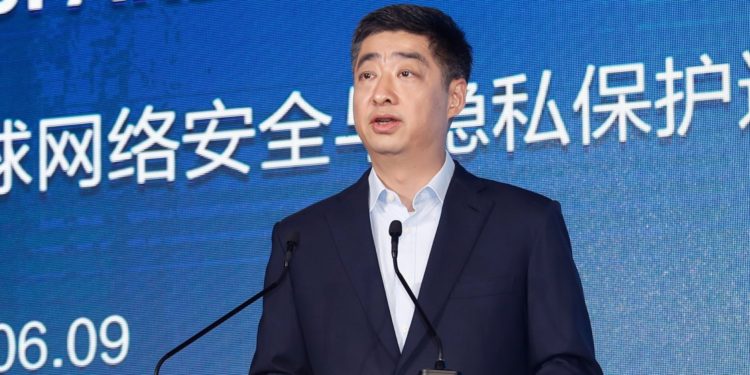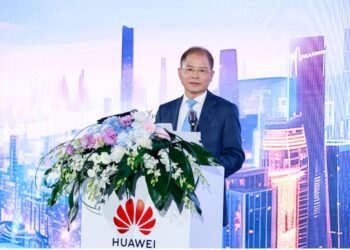Huawei on Thursday opened its largest Global Cyber Security and Privacy Protection Transparency Center in Dongguan, China. It used the event, which included representatives from GSMA, SUSE, the British Standards Institution, and regulators from the UAE and Indonesia to call for a unified approach to cybersecurity based on facts and verification, rather than suspicion and misconceptions.
“While we are deepening digitalisation across the world, cybersecurity is becoming more important than ever before,” says Dr Ken Hu, Rotating Chairman, Huawei. “According to research from Cybersecurity Ventures, damages from cybercrime are set to reach US$6-trillion in 2021.”
Pointing to the rise of remote work and the increased amount of time people are spending online as a result of the pandemic, he points out the globe is facing deeper cybersecurity challenges than at any other time in its history.
In order to address these challenges, Hu says, a unified, collaborative approach between corporations, nation states, regulators, and industry bodies is required.
“Cybersecurity is a complex, evolving challenge that requires collaboration,” he says. “In some places there is still a misconception that country of origin affects network security. This is not true and prevents us from taking a unified approach to cybersecurity.”
The new transparency centre, he says, aims to change that and help facilitate collaboration across the ecosystem.
“At Huawei, cybersecurity is our top priority,” he says, pointing out that the company employs more than 3 000 cybersecurity professionals and spends five percent of its R&D budget on cybersecurity.
“The new centre will demonstrate solutions, facilitate communication and joint innovation, and support stakeholders around the world,” he adds.
The event also saw Huawei launch its Product Security Baseline Whitepaper, which represents a further step in its quest for cybersecurity collaboration.
The whitepaper sets out the end-to-end framework which Huawei uses when it develops, tests, and launches products to ensure that they’re as secure as possible.
“The baselines outlined in the whitepaper ensure all Huawei products keep to regulatory standards,” says Sean Yang – Director of Huawei Global Cyber Security and Privacy Protection Office.
In making the baselines public, Huawei hopes to further foster a spirit of collaboration and transparency.
“We want to share knowledge with all stakeholders, to help ensure that end users are kept secure while having their privacy protected,” he adds.
Adding to the clarion-call for collaboration on cybersecurity were Andy Purdy, Chief Security Officer, Huawei Technologies USA and Prof. Dr Ernest Ketcha Ngassam, General Manager of Information Security Architecture and Technical Excellence, MTN.
“The value that technology can bring requires a shared responsibility,” says Purdy. “That means collaboration not just in standards but also when it comes to sharing information about practices, and improving procurement requirements.”
“If we don’t have accountability for requirements,” he adds, “people are going to think you don’t care about them.”
It is really difficult to implement a cybersecurity defense strategy in a vacuum,” says Ngassam. “The supply chain needs to be transparent to enable customers to take action sooner rather than later.”
Closing out the launch event was John Suffolk, Huawei Global Cyber Security and Privacy Officer. He pointed out that the rapid pace of technological evolution means that standards can only take you so far.
“We need to recognise that in a real-time world that standards are important but they’re not your saviour,” he says. “You need to make sure that your products and solutions are going through continuous assessment.”
Here too, collaboration is important.
“At Huawei, we take a ‘many eyes and many hands’ approach to security,” Suffolk says. “The more people looking at something and the more people touching it, the better. Transparency and collaboration is therefore critical.”
“We’re at an inflection point,” he adds, “and if we’re to embrace the promise of the ongoing digital revolution, we all need to work together to ensure everyone works transparently to keep the ecosystem as safe as possible.”
-Ends-
About Huawei
Huawei is a leading global provider of information and communications technology (ICT) infrastructure and smart devices. With integrated solutions across four key domains – telecom networks, IT, smart devices, and cloud services – we are committed to bringing digital to every person, home and organization for a fully connected, intelligent world.
Huawei’s end-to-end portfolio of products, solutions and services are both competitive and secure. Through open collaboration with ecosystem partners, we create lasting value for our customers, working to empower people, enrich home life, and inspire innovation in organizations of all shapes and sizes.
At Huawei, innovation focuses on customer needs. We invest heavily in basic research, concentrating on technological breakthroughs that drive the world forward. We have more than 180,000 employees, and we operate in more than 170 countries and regions. Founded in 1987, Huawei is a private company fully owned by its employees.
Do you have a story in your community or an opinion to share with us: Email us at editorial@watchdoguganda.com









